General
LANDFIRE Standard Projections
CONUS
Projection type: USA Contiguous Albers Equal Area Conic (referenced as NAD_1983_CONUS_Albers (EPSG:5070))
Spheroid name: GRS 1980
Datum name: NAD83
Latitude of 1st parallel: 29.50 N
Latitude of 2nd parallel: 45.50 N
Longitude of central meridian: -96.00 W
Latitude of origin of projection: 23.00 N
False easting at central meridian: 0.0 meters
False northing at origin: 0.0 meters
Puerto Rico/Virgin Islands (PR/VI)
Projection type: USA Contiguous Albers Equal Area Conic (referenced as NAD_1983_CONUS_Albers (EPSG:5070))
Spheroid name: GRS 1980
Datum name: NAD83
Latitude of 1st parallel: 29.50 N
Latitude of 2nd parallel: 45.50 N
Longitude of central meridian: -96.00 W
Latitude of origin of projection: 23.00 N
False easting at central meridian: 0.0 meters
False northing at origin: 0.0 meters
Alaska
Projection type: Alaska Albers Equal Area (referenced as NAD_1983_Alaska_Albers (EPSG:3338))
Spheroid name: GRS 1980
Datum name: NAD83
Latitude of 1st parallel: 55.000 N
Latitude of 2nd parallel: 65.00 N
Longitude of central meridian: -154.00 W
Latitude of origin of projection: 50.00 N
False easting at central meridian: 0.0 meters
False northing at origin: 0.0 meters
Hawaii
Projection type: Albers Equal Area (referenced as Hawaii_Albers_Equal_Area_Conic (ESRI:102007))
Spheroid name: GRS 1980
Datum name: NAD83
Latitude of 1st parallel: 8.00 N
Latitude of 2nd parallel: 18.00 N
Longitude of central meridian: -157.00 W
Latitude of origin of projection: 13.00 N
False easting at central meridian: 0.0 meters
False northing at origin: 0.0 meters
Insular Areas (IA)
Projections are in best fit WGS 1984 UTM for Northern and Southern Hemispheres
LF users can download the CONUS, Alaska, Hawaii and Puerto Rico/Virgin Island Mapzone Extent shapefiles, which CONUS and Alaska includes both the 90k and 0k shapefiles, from our Data page.
LANDFIRE products were designed to support national, regional, and sub-regional analysis activities.
Considerations:
- The native spatial resolution of LANDFIRE raster spatial products is 30-meters, however, the appropriate application scale is much larger than 30 meters, and will vary by a combination of product, location, and specific use.
- Users should refer to the metadata and local, regional or expert knowledge to determine if LANDFIRE products are appropriate for their application in their area.
- LANDFIRE products are not intended to replace local products, but serve as a rich supplemental data source with complete areal coverage, regardless of ownership.
| What do you want to cite? | Model | Example |
| General information from www.landfire.gov | Homepage title. (Last update). [Homepage of], [Online]. Available: URL [Access date]. | LANDFIRE. (2013, January - last update). [Homepage of the LANDFIRE Project, U.S. Department of Agriculture, Forest Service; U.S. Department of Interior], [Online]. Available: https://www.landfire.gov [2013, February 8]. |
| LANDFIRE spatial data products | Homepage title: Data product. (Last update). Agency. [Online]. Available: URL [Access date]. | LANDFIRE: LANDFIRE Existing Vegetation Type layer. (2013, June - last update). U.S. Department of Interior, Geological Survey, and U.S. Department of Agriculture. [Online]. Available: https://landfire.gov/viewer/ [2013,May 8]. |
| LANDFIRE non-spatial data products | Homepage title: Data Product. (Last update). [Homepage of], [Online]. Available: URL [Access date]. | LANDFIRE: LANDFIRE Vegetation Dynamics Models. (2013, June - last update). [Homepage of the LANDFIRE Project, U.S. Department of Agriculture, Forest Service; U.S. Department of Interior], [Online]. Available: https://www.landfire.gov/ [2013, May 8]. |
- Install the Raster Attribute Table (RAT) plugin, install: https://plugins.qgis.org/plugins/RasterAttributeTable/
- Add the raster file to QGIS
- If a RAT exists you will see the RAT available bar, shown below
- If data was downloaded from LF Viewer or from the website page for Mosaic Downloads, the attribute table is included
- If data was downloaded from the LFPS tool, an attribute table can be found on the product page.
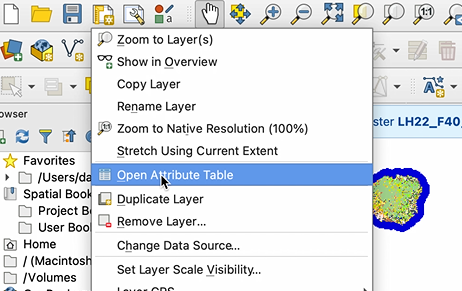
- If you do not see the RAT available bar, right click on the raster file, and either select your attribute table, or add your attribute table
- Open the RAT
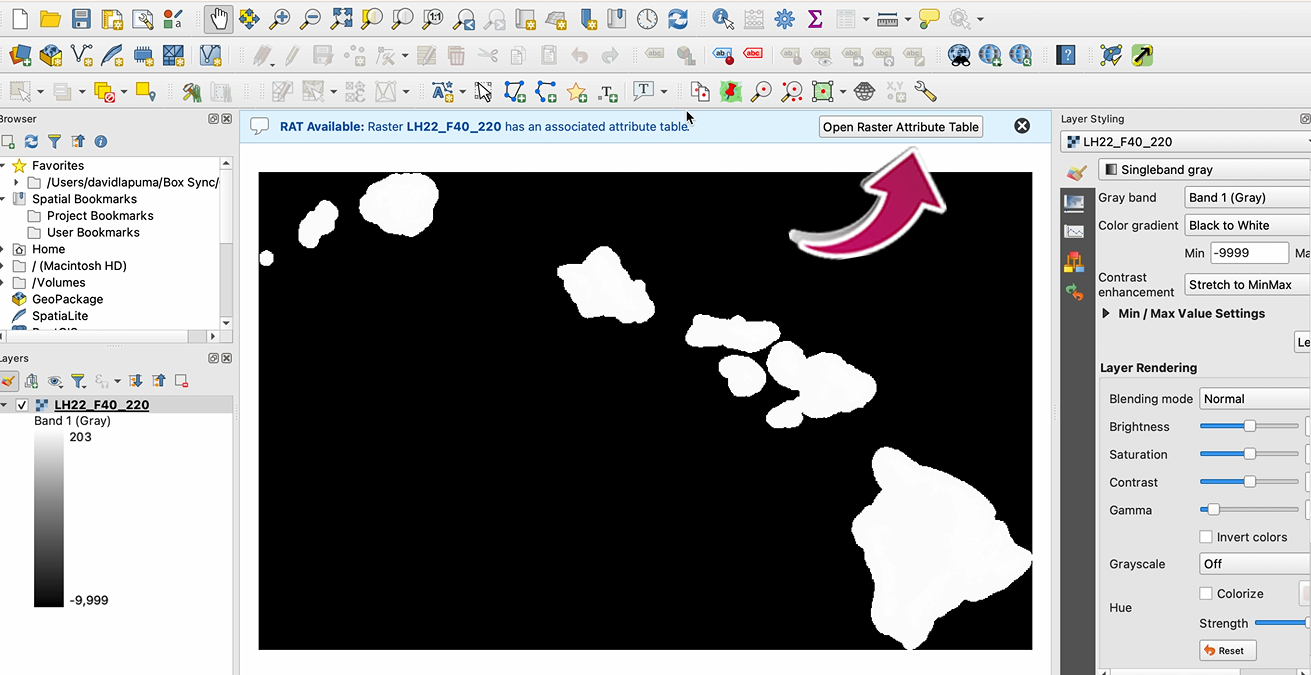
- Select your Classification from the drop-down: (FBFM40) Red, Green, or Blue
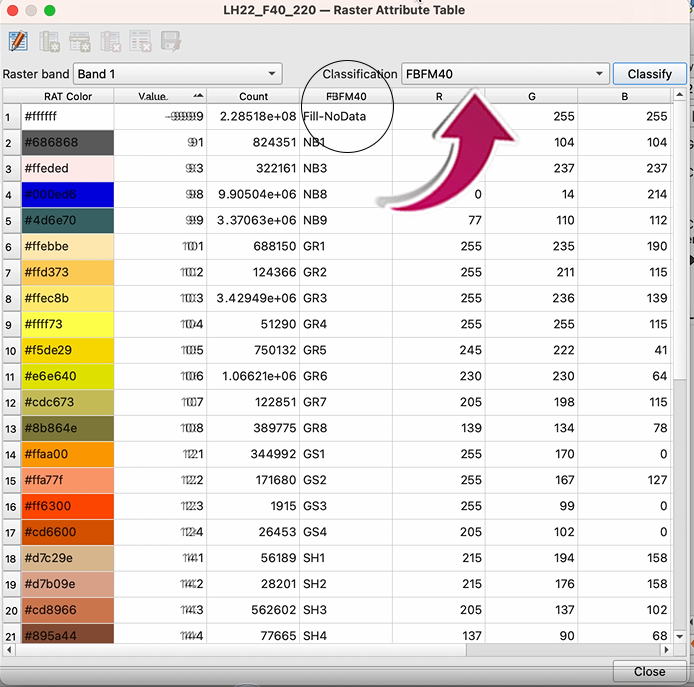
- Click on the Classify button
- A pop-up window will ask if you want to overwrite the existing classification--select YES
- The attribute table should now appear in QGIS.
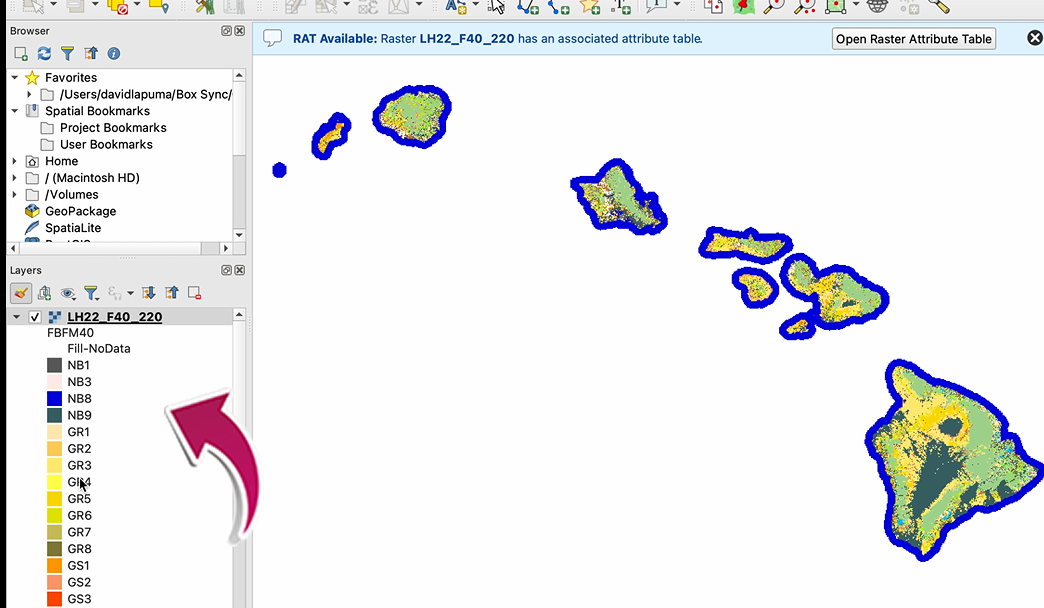
A LANDFIRE Landscape GeoTIFF (landscape) file is a multi-banded raster. The data type for all bands is 16-bit signed integer. Bands are interleaved by pixel. Five bands are required: elevation, slope, aspect, fuel model, and tree canopy cover. You can download either Fire Behavior Fuel Models 13 (Anderson, 1982) or 40 (Scott and Burgan, 2005) as a landscape file using the map viewer with the “Data Download Tool”.
An update program is vital to support the full spectrum of fire and natural resource management programs with timely and quality products that reflect recent changes in landscape conditions. The LANDFIRE updates focus on landscape changes to vegetation and fuels resulting from disturbance and treatment activities such as wildland fire, fuel and vegetation treatments, mortality from insects and disease, storm damage, invasive plants, and other natural or anthropogenic events. Areas of concern will be improved through the LANDFIRE update process, and the existing layers will be updated to reflect more current conditions.
Our suggestion is to consider your intended use. LF native projection, USA Contiguous Albers Equal Area Conic (NAD_1983_CONUS_Albers or NAD_1983_Alaska_Albers), is perfect for larger area analysis, such as multiple states, etc. However, when doing any other types of analysis, such as local analysis, one may need to adapt LF products. If you are using software applications like FlamMap or FARSITE, it is best to reproject the products and use a north up projection, such as Best-FIT UTM (NAD83). If data are not reprojected to a north up projection, models could produce unexpected results. It's good practice to understand the map projection characteristics of the products and, when necessary, reproject them to best fit your needs. LF viewer download options allow you to choose NAD 1983 Albers (Standard Projection) or Best-Fit UTM (NAD83 Datum).
We need data that can be used to update LANDFIRE data layers, and data that could be used to remedy known concerns with previous versions. In a nutshell, we need Event data on any recent (current update cycle) disturbances or vegetation/fuel treatments that would have altered the composition or structure of vegetation and/or fuel. In addition to Event data, LANDFIRE also benefits from point or polygon vegetation or fuel plot data which may be incorporated in the LANDFIRE Reference Database (LFRDB).
ArcGIS
 A significant aspect of managing each map layer is the ability to set a wide array of layer properties in the Properties dialog box. To display as LANDFIRE displays on the viewer:
A significant aspect of managing each map layer is the ability to set a wide array of layer properties in the Properties dialog box. To display as LANDFIRE displays on the viewer:
ArcMap:
- Right click the layer in ArcMap
- Click on Properties
- Click on Symbology
- Select Unique Values
- In Value Field use the dropdown to select the desired field
- To display your data in the same way that the map viewer does, select the "Name or Label" field
ArcPro:
- Right click on the layer in ArcPro and select Symbology
- A dialog box will open, under Primary Symbology select Unique Values from the dropdown list
- Below that box, you will see Field 1, use the dropdown to select the desired field for display
- To display your data in the same way that the map viewer does, select the "Name or Label" field
It may also be helpful to review the "Setting layer properties" on the ArcMap web page or ArcPro web Page prior to working with LANDFIRE products.
With the release of the new viewer, ArcGrid, LFDAT, and Non-ESRI scripting (data access ESRI tools and formats) were archived. LF is changing technology to move with the industry towards GeoTIFF. As a result, ArcGrid will no longer be supported as we move technologies to Open Geospatial Consortium (OGC) standards.
LANDFIRE Product Service (LFPS)
LFPS produces multi-band GeoTIFFs which are multi-band floating-point raster datasets. Because raster attribute tables can only be built for single-band integer raster datasets, multi-band GeoTIFFs cannot have an attribute table joined. To remedy this, you can export individual bands from the LFPS output and join with an attribute table.
LF Attribute Tables are in the Comma Separated Value (CSV) format. To find the appropriate .csv file, go to the product pages and select the Comma Separated Value (CSV) link. Download the .csv file(s) and then follow the steps detailed in the instructions below:
Note: Since these are multi-band GeoTIFFs, drag-and-drop into ArcPro will not work. Users must use the recommended process of clicking on "Add Data" to bring their GeoTIFF into ArcPro.
ArcMap/ArcGIS Pro
- Click the Add Data dialog box (this is different for ArcMap vs ArcGIS Pro)
- Click on the file name of the LFPS GeoTIFF (make sure you expand the zip file first)
- Select and add the individual band(s) to which you want to join attributes
- Export each band as format TIFF
- In the Layer Properties menu, change the symbology in each band to Unique Values and select Yes to build a raster attribute table
- Join the attributes based on Value and the relevant attribute table (.csv) table
- Export the raster again to make the join permanent
As shown in the images below, the categorial information is missing from the multi-band GeoTIFF downloaded from LFPS, but after joining the attribute table to the individual exported raster, the attribute information is present.
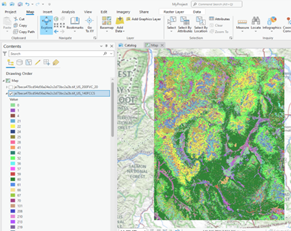
| 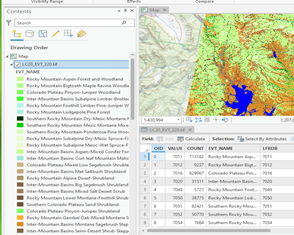
|
The LFPS can be accessed in several ways:
- ESRI's REST API/Web Interface at https://lfps.usgs.gov/arcgis/rest/services/LandfireProductService/GPServer
- Python, php, unix wget, or anything that can call a URL (including an internet browser)
- Scripting tools like Postman (https://www.postman.com/)
LF Product Service (LFPS) is a RESTful Application Programming Interface (API) that allows users to request and download a LF products file, an output file incorporating the requested product layers via a multiband raster, through an API using HTTPS requests. Features of the LFPS include:
- Resampling product layers to a coarser resolution, defining an output projection for a study area, and editing select product layers based on rules using other product layers within the products file
- 100% RESTful
- Supports GET & POST for Endpoints
- All Downloads Endpoint(s) support Cross-Origin Resource Sharing (CORS)
- Asynchronous by default


